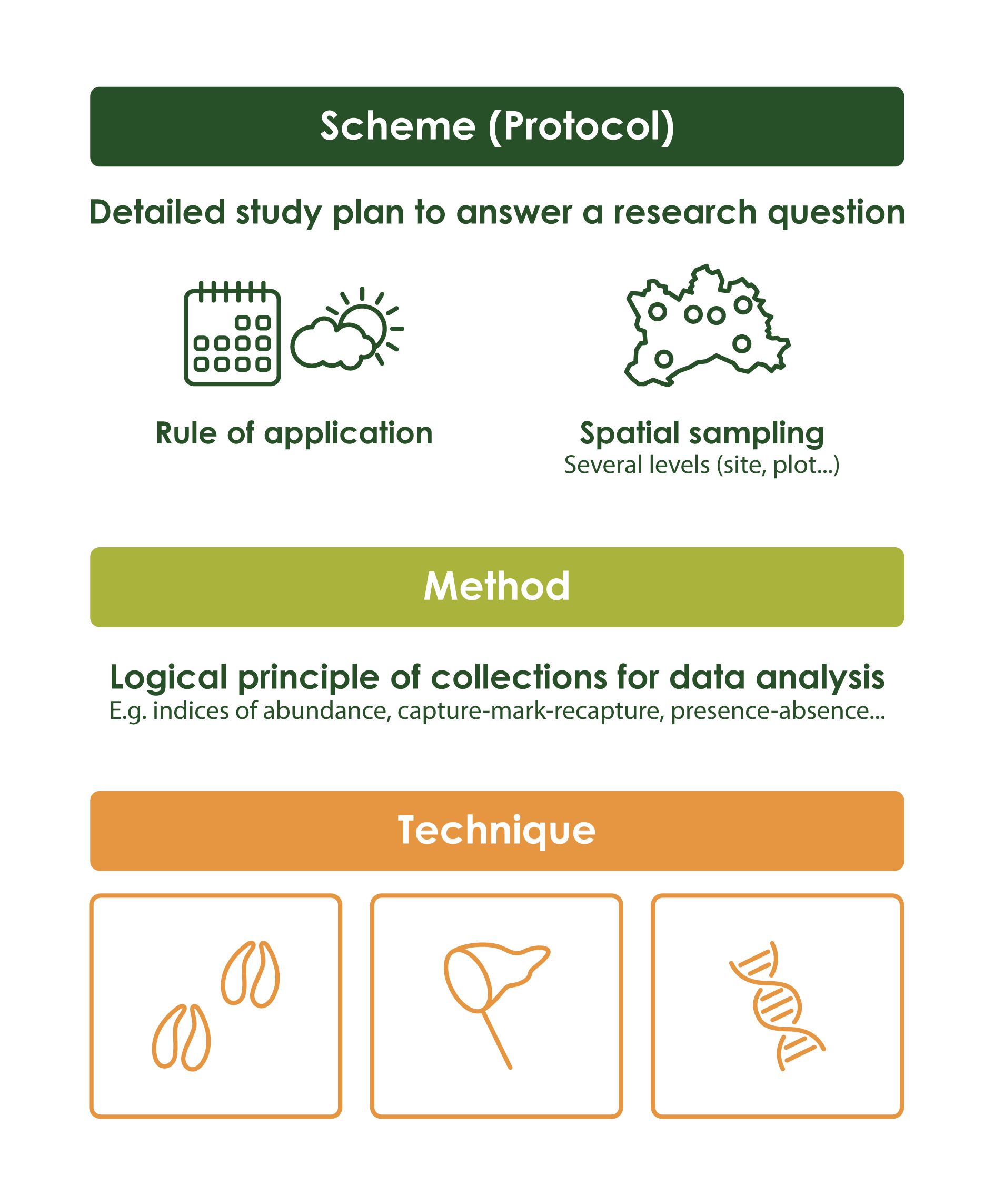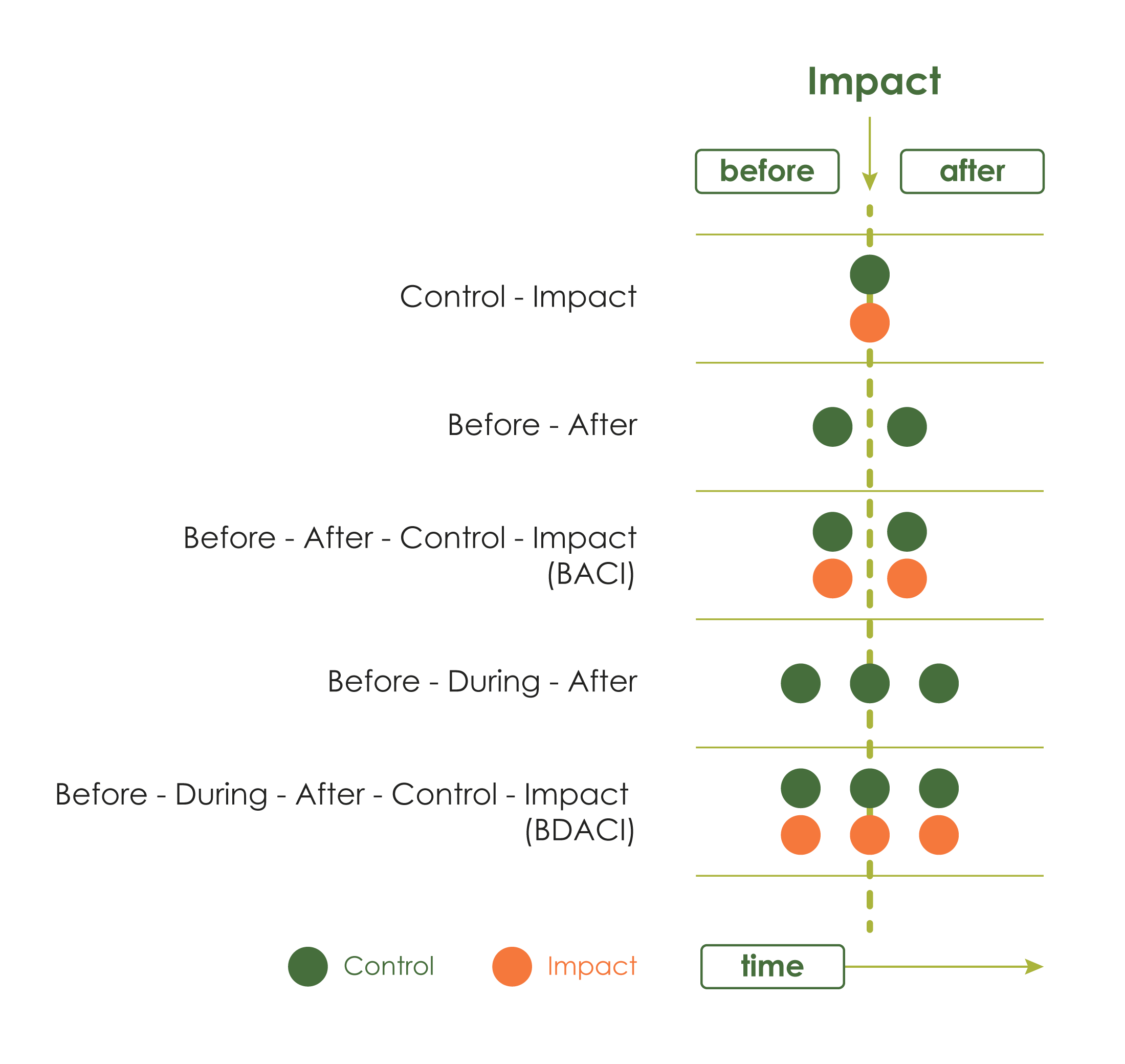Designing a monitoring plan involves the selection and the organisation of schemes or protocols, methods and techniques (Figure 6.2.3).
- A scheme (also called protocol)is a detailed plan explaining how data must be collected and analysed to answer a research question. It includes:
- A sampling plan defining procedures for selecting and collecting the elements to be studied.
- Methods and techniques to be applied.
- Application procedures (e.g., duration, frequency, factors of influence to be registered, and other).
- A method can be defined as a logical process aiming at meeting a general objective (e.g., estimation of a population size, through the organised collection of data). A method thus mobilises one or more techniques for the acquisition of data in the field and it is part of a standardised scheme.
- A technique refers to the set of specific skills, processes and tools that are used in a logical way to collect data associated with a parameter to be observed or an ecological factor to be considered. A technique is defined in relation to a target. Within the framework of a scheme, it must be replicable in other locations and times.
To ensure comparability and replicability of monitoring activities it is important to follow these principles when collecting data from field surveys:
Do not change methods over time. To obtain comparable data throughout a monitoring and evaluation period the schemes and methods implemented must not be changed during that period.
Use the same, standardised scheme and methods and the same metrics to monitor mitigation measures or biodiversity targets in the different study sites. This will generate comparable data which can be used for evaluation and to inform decisions in other situations with similar conditions.
Include at least the following data in the monitoring and evaluation databases:
- WHAT (species or mitigation measure type)
- WHERE (location where monitoring took place)
- WHEN, HOW LONG and HOW OFTEN (prospection time and effort)
- HOW (scheme, methods and techniques applied)
- WHO (responsible to undertook the monitoring)
A recommended scheme for monitoring studies: the BACI framework
To determine the effect of a project on selected target species or habitats as accurately as possible and with reliable results, it is recommended to apply the Before-After-Control-Impact (BACI) methodology process. It consists of collecting data after the project have been constructed (‘After’), but also to register baseline conditions (‘Before’) to be compared. Moreover data are gathered not only in the area that is affected (‘Impact’ area) but also in another site with similar conditions that is not being affected by the impact (‘Control’ area). Although this approach is difficult to apply to the evaluation of the impacts of a complete infrastructure project, it must be considered as a reference to be adopted, when possible.
The BACI scheme is recommended to be used in ecological studies and are non-randomized methods that can employ a variety of statistical tests. There are several variants of the BACI methodology, depending on the spatial or temporal scale, the most complete method being BDACI (D for ‘During’ which is the monitoring to be applied during the intervention: e.g., construction of the infrastructure). Figure 6.2.4. summarizes the main types of schemes that can be used in an intervention.
It is essential to consider the replicability of monitoring and evaluation schemes because this ensures the reliability and the robustness of the results obtained.
If for any reason related to the quality of data available, budget, duration of the study or another reasons, it is not possible to apply a BACI methodology, the closest methodology approach should be applied instead. It is important to highlight that comparison of data is possible, even if the experimental design does not follow the BACI approach; e.g. monitoring involves taking measurements on a site at regular time intervals and comparison is then possible between inventories carried out over time.
When monitoring schemes and methods are defined, it is important to evaluate the time and budget necessary according to the variables to be registered, number of sites to be compared, frequency of censuses and other. An adaptation of the scheme and methods could be necessary for adapting to the resources available and the reliability of the results to be obtained.

